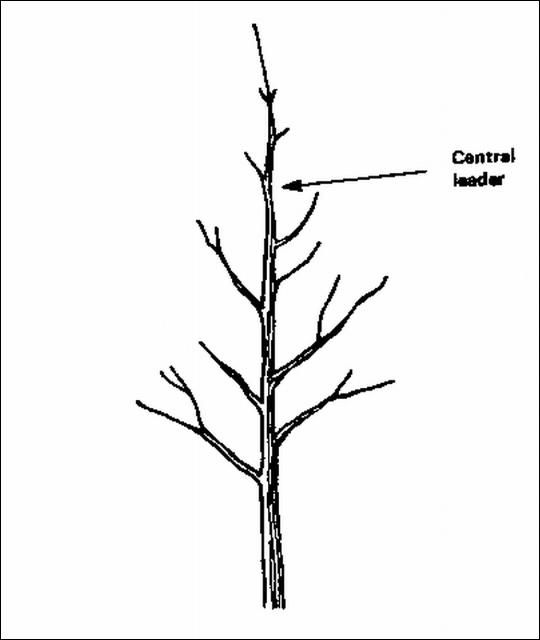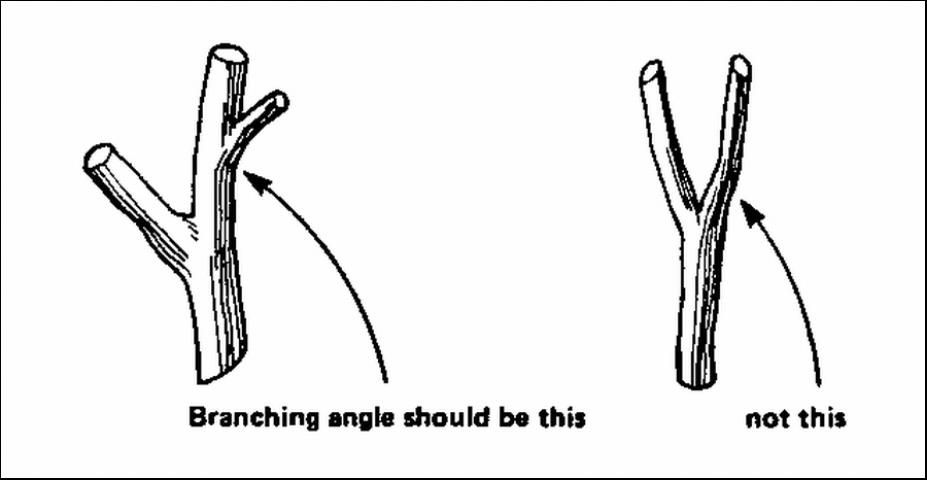When an area has been free of hurricane-strength winds for a number of years, there is a possibility of severe damage to trees and to the structures near them when a storm finally hits. Trees and shrubs, even those native to an area, can grow too massive or unbalanced to be able to stand windstorms, and it is worth learning how to prune and shape trees in order to minimize the risks of damage.
The ideal approach to avoiding storm damage begins with the initial selection of the plants. Such selection takes into consideration the branch and trunk strength of the trees being considered for planting, how strong their root system is, and their placement relative to structures and utilities. A regular system of pruning must then be established; pruning should develop a sturdy, well-spaced framework of healthy branches carrying an open, leafy canopy that allows air to move freely.
Trees Resistant to Wind
There are some tree species that stand up to strong winds much better than others. (No tree can be guaranteed to stand up to hurricane-force winds or even strong gusts of wind. This is particularly true if it has been growing unpruned for a number of years.) These trees are more likely to withstand strong winds.
-
Cordia sebestena—geiger tree
-
Mangifera indica—mango
-
Manilkara roxburghiana—mimusops
-
Quercus virginiana—live oak
-
Tamarindus indica—tamarind
Most palm species.
Brittle Trees
At the other end of the scale are the trees noted for dropping branches or splitting apart under stress. Losing leaves or twigs in a high wind will make a garden untidy, but may give the trees an advantage by reducing the stress on the main branches. The trees on this list are likely to lose major limbs.
-
Acacia auriculiformis—earleaf acacia
-
Bischofia javanica—bischofia
-
Enterolobium cyclocarpum—ear tree
-
Eucalyptus spp.—eucalyptus
-
Grevillea robusta—silk oak
-
Hibiscus tiliaceus—sea hibiscus
-
Persea americana—avocado
-
Spathodea campanulata—African tulip tree
Most species fall between the extremes and have a good chance of surviving a moderate to strong storm intact, provided they have had proper pruning.
Shallow-Rooted Trees
Another class of damage occurs when the whole tree blows over rather than breaking up. The soil in which the trees are growing may have a major influence on how shallow-rooted a tree is, but there are certain species that almost never make deep roots, and these are always likely to blow over. On poorly drained soils, such as marl, where the water table periodically comes close to the soil surface, most trees that would otherwise form deep roots will be shallow-rooted and much more easily blown over than they would be on well drained soils. It is interesting to consider that in nature, blowing over rather than breaking up may help the tree to survive. The roots left in the ground supply the fallen tree with nutrients and new upright shoots form from the base and along the trunk. In a controlled landscape this is not a desirable characteristic, but it may be an advantage in semi-wild situations, particularly along the coast.
Species with shallow root systems include:
-
Albizia lebbek—woman's tongue
-
Bulnesia arborea—vera wood
-
Casuarina spp.—Australian pine
-
Ficus microcarpa—Indian laurel
-
Peltophorum spp.— yellow poinciana, copperpod
-
Thespesia populnea—seaside mahoe
Planting Considerations
When a tree falls or breaks up it is more likely to damage a structure close to it than one farther away. If the landscape planning includes the use of trees to shade the house, some compromise will be necessary to avoid the shade trees turning into wreckers during a storm. It is more important to shade the east and west walls than the roof. Small trees could be planted fairly close to the house to accomplish this, and they would be much less hazardous than larger trees, even if the larger trees were farther away. Observations of native tree hammocks in Dade County suggest that a large number of trees close together may be an effective storm protection for structures, but no definitive testing of this theory has been carried out. Overhead utility lines are even more vulnerable to damage than the roof or windows of a house, and there should be no tree branches close enough to drop across them or even brush against them.
Once the tree has been selected and planted in such a place as to reduce hazards, there still remain cultural practices throughout the life of the tree that will affect its survival during a storm.
When planting, the usual advice has been to dig a large hole, put the tree in the hole, and fill around the ball of roots with enriched soil. Under certain circumstances, this may be exactly the wrong thing to do! In really bad soil or rock, the hole full of rich soil may allow the tree roots to get off to a good start, but the roots may take a long time to grow from the good soil into the poor soil surrounding it. Roots may coil around in the hole just as they would in a pot, and with the same disadvantages: a danger of encircling and constricting the lower part of the trunk, a limited volume from which to draw water and nutrients, and very little resistance to being blown over.
If the soil is enriched or amended before planting, use no more than 1/3 organic matter (by volume) mixed well with the original soil from the site, making this addition to an area large enough to support an extensive root system. If this is not feasible, plant the tree in unamended soil and pay close attention to watering and fertilizing until the tree roots have grown out strongly. Use of organic mulches 3 to 4 inches deep around the tree (but not touching the trunk) will help with the establishment of the tree by keeping the ground cooler, moister, and with fewer weeds than if the ground were bare. The mulch will gradually improve the soil, too.
In Dade County, where limestone can be a problem, dynamiting before planting is very helpful in opening cracks through which the roots can travel. Once established, trees planted in this way are extremely resistant to blowing over. Unfortunately, dynamiting is not allowed in many areas.
Pruning for Wind Resistance
The most wind-resistant form for a tree is one with a central leader and a well-spaced framework of branches around and up and down the trunk (Figure 1). Most trees can be grown in this form when they are young, but the growth habit of some species will change to a multi-trunked spreading form as they mature.

There should be no narrow forks or branches leaving the trunk at an acute angle (Figure 2), since these branches are likely to split under stress. Crotches from 45 to 90 degrees are less likely to split than narrow V-crotches of less than 40 degrees.

A wind-resistant tree is the result of regular care since its early life. Young trees should not be cut back to make them bushy, but should rather be encouraged to form a strong leader with well-spaced laterals (branches that go out to the side) that are held back enough to stop them from forming multiple, competing leaders (Figure 3).

A young tree in the form shown in Figure 3 can have the lower branches removed over a period of time to give a clear trunk to whatever height is necessary. It should not, however, be cleaned of laterals in the lower part of the trunk too soon, since the branches there (provided they are not allowed to form competing leaders) will help to give a larger trunk diameter and a much sturdier tree (Figure 4).

Later pruning should consist of forming a well-spaced framework of strong branches, and a pleasing outline to the tree.
Preparing for a Storm
Faced with the threat of a storm, gardeners who have kept their trees thinned and with a canopy in proportion to the trunk and branches have little extra to do. The overgrown, neglected tree, however, is another matter. It may be necessary to reduce the size of the tree, which will be a minor operation and hardly noticeable for a tree which has been well maintained. For a neglected tree it will mean severe surgery and a tree that will be ugly for a few months whether or not the storm hits.
The order of pruning is always the same (Figure 5).

-
Cut out dead, diseased, and damaged wood.
-
Take out watersprouts.
-
Cut out crossing branches and those growing into the center of the tree.
-
Clean off small branches that clutter the center of the tree.
-
Select a well spaced framework of branches and cut all others out completely.
-
Shorten branches to give a balanced head.
Whenever possible, this shortening should be done to a bud that has already started to grow out as a sidebranch. (Figure 6). Cutting to an upward pointing branch or one leading to one side or the other will determine the direction in which new growth occurs for a time. If the tree has been well managed, pruning in this way (drop crotch pruning) will mean that the cuts scarcely show since a lot of foliage will remain to disguise them. In cutting back a neglected tree, many of the cuts will have to be made to a part of the branch with no leaves or side branches. Even when the cut can be made to a fork, the remaining branch may also need to be shortened so that the cuts have very little foliage to hide them.

Heading back (cutting branches severely to a bare stump) should be avoided unless absolutely necessary. Not only does this risk sunburn for all the trunk suddenly exposed to the light, but it also means that a tuft of twigs will grow from each stump which will have to be thinned later. All cutting should be done so as to avoid damage to the parts of the tree that are to remain. Cuts should be finished close to the trunk or remaining branch and at the angle shown in Figure 7 so that they will heal well. Painting the cuts is not recommended. It is of no value in promoting healing, although it may help to disguise the cut.

If you have coconut palms, preparing for storms includes harvesting all nuts that are of any size. Coconuts and most other large palms should have dead leaves removed. The nuts and the leaves can act as missiles if the wind catches them right. Do not, however, cut off all leaves except the central upright tuft, since this removes the protection for the bud (Figures 8 and 9). Last minute prunings can also blow around dangerously and should thus be disposed of for safety.

Credit: D. Caldwell

Credit: D. Caldwell
Windstorms are always a matter of concern, but trees that have been selected properly, sited with care, and maintained so as to have a sturdy form and an open canopy stand the best chance of surviving intact and not adding to the damage in the area.